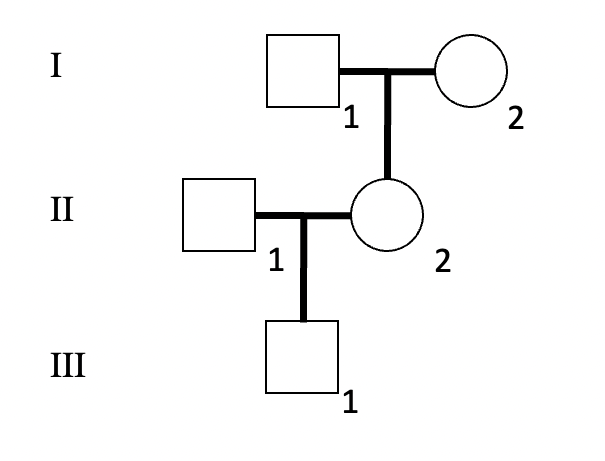There are two genetic disorders that result from mutation in imprinted genes: Prader-Willi syndrome, Angelman syndrome. Angelman syndrome results from deletion of UBE3A, which is a gene imprinted such that only the maternal copy is expressed. In the pedigree above, individual I-1 is heterozygous for a deletion of UBE3A and does not have Angelman syndrome. Individual I-2 is homozygous wild type for UBE3A. Which individuals in the pedigree are at risk for exhibiting Angelman syndrome, if any? (Who could potentially have the syndrome, based on what alleles it is possible for them to inherit and express?) Question 8 options: Only I-1 could have been at risk. If he does not have the syndrome, no one in the pedigree could. Only III-1 is at risk I-1, II-2, and III-1 are all at risk Only II-2 is at risk No one in the pedigree is at risk Both II-2 and III-1 are at risk III-1 is only at risk if II-1 is heterozygous for the deletion, too
There are two genetic disorders that result from mutation in imprinted genes: Prader-Willi syndrome, Angelman syndrome. Angelman syndrome results from deletion of UBE3A, which is a gene imprinted such that only the maternal copy is expressed.
In the pedigree above, individual I-1 is heterozygous for a deletion of UBE3A and does not have Angelman syndrome. Individual I-2 is homozygous wild type for UBE3A. Which individuals in the pedigree are at risk for exhibiting Angelman syndrome, if any? (Who could potentially have the syndrome, based on what alleles it is possible for them to inherit and express?)
Question 8 options:
|
|
Only I-1 could have been at risk. If he does not have the syndrome, no one in the pedigree could. |
|
|
Only III-1 is at risk |
|
|
I-1, II-2, and III-1 are all at risk |
|
|
Only II-2 is at risk |
|
|
No one in the pedigree is at risk |
|
|
Both II-2 and III-1 are at risk |
|
|
III-1 is only at risk if II-1 is heterozygous for the deletion, too |

Step by step
Solved in 7 steps






